Of course, when I signed up for a tour to see 1000 easy payday loan the Seven Wonders of Kuala Lumpur, I was a little sceptical. I mean, sure there are maybe one or two landmarks in Kuala Lumpur that I would consider a “wonder” like the iconic Petronas Twin Towers or the 421 metre spindle-pointed Kuala Lumpur Tower. That’s two, but seven wonders? Really? Imagine my surprise when my guide told me that neither two are on the list of seven we will be visiting!
It was around 10 in the morning when the tour van picked us up at the hotel. There were seven of us in total, eight plus our guide cum driver, Thomas. Two Canadians, a German and two Belgians are all travelling around the region. After a brief introduction on the itinerary for the day, we set off for the first stop.
Also read: Which Parts of Malaysia You Won’t Regret Visiting
Wonder #1: The Old Colonial District of Kuala Lumpur and the City Gallery

Sure, I have been to KL plenty of times. It is after all just a stone’s throw away from neighbouring Singapore. But it was always along the shopping belt around Bukit Bintang. Never have I been to this Old Colonial District. So you can imagine my surprise getting off the van and seeing the Independence Square, where the flag proclaiming Malaysian independence was first raised, and the buildings at its perimeter. There were European influenced buildings with Moorish architecture, Corinthian columns capped with Mughal domes. All remarkably restored and housing various museums.
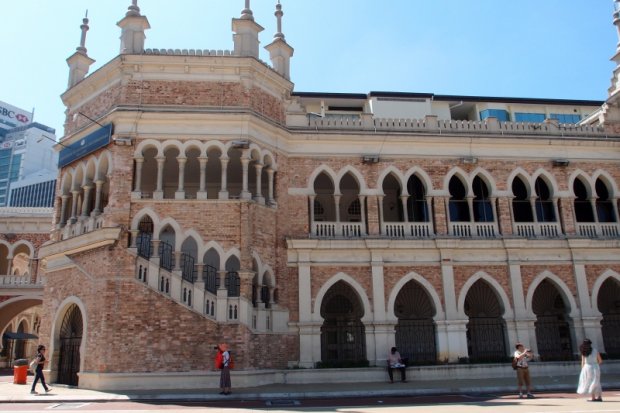
Indo-saracenic revival architecture seen in Merdeka Square
We made for one of the museums – the City Gallery is housed in a historical building constructed in 1899. Inside, interactive displays recount the history of Kuala Lumpur, starting from when it was a quiet tin mining settlement to its current status as the capital of Malaysia. The centrepiece of the City Gallery is a 12m x 15m room, complete with sound and light displays, containing the largest scale model of Kuala Lumpur City.
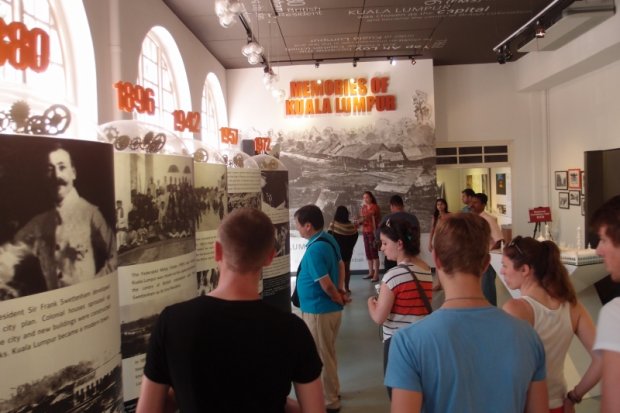
The City Gallery tells the history of Kuala Lumpur from its humble beginnings as a tin mining town.
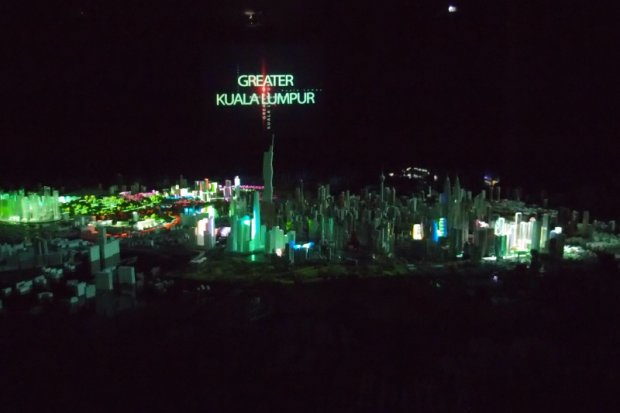
The sound and light show in the room featuring the largest scale model of the city of Kuala Lumpur.
Wonder #2: Batu Caves
To the north of the city, the next destination on our tour: The Batu Caves. This is one of the more well-known sights of Kuala Lumpur, and has been on my ‘to visit’ list for quite a while. The Batu Caves is a complex of large limestone caverns located at the top of a hill. It is also the site of a Hindu temple to one of the main deities worshipped in South India, Lord Murugan, explained Thomas.
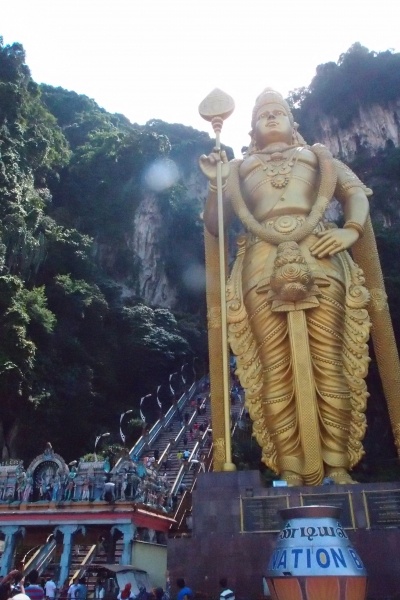
The 42.7 m high figure of Murugan stands proudly overlooking the temple devotees.
“Wow”. As the van approached the site, the unmistakable towering gold-painted statue of Murugan, all 42.7m of him, came into view. Here was the tallest single figure of Murugan in the world. Just off to his left, 272 steps rise up to the top of the hill. We started to climb.
Some bits of info, garnered from my knowledgeable guide and my background as a museum guide myself. Murugan, sometimes known as Kartikeya or Subrahmanya, is the Hindu god of wisdom. The son of Shiva and his consort Parvati, Murugan is worshipped especially in South India. And in Malaysia, where the Tamil community primarily originated from South India, Murugan is very relevant and important.
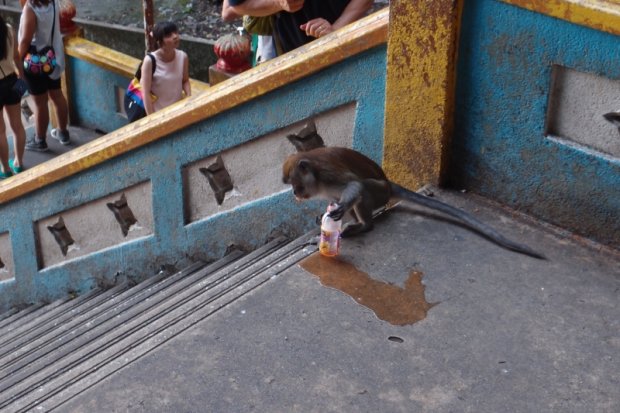
A monkey enjoying the drink he grabbed off someone.
As we climbed the steps, I cannot help but notice the excitable monkeys. These monkeys of Batu Caves are notorious for their boldness. They would come up to visitors and grab any food, loose items and water bottles right off their unsuspecting victims. And indeed, we saw one making for a plastic bag of snacks, grabbing it off a lady and not letting go. A mini tug-of-war ensued, until the lady gave up and released the bag. Monkey 1 Lady 0.
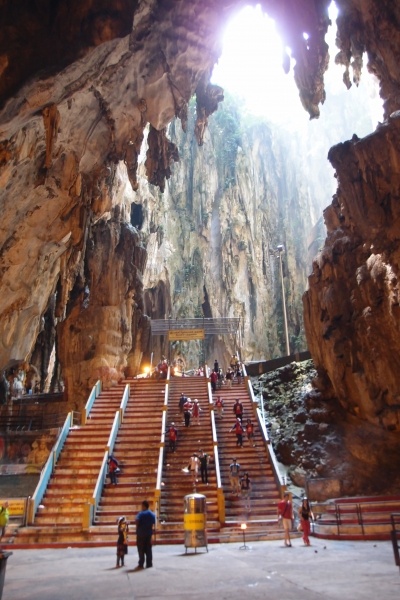
The interior part of the cavern at the top of the Batu Caves hill.
At the top of the steps, the cave opened up into a high ceiling cavern. There were shrines everywhere. The last one at the end, which I assumed was the inner shrine, had all these devotees offering their prayers, and then engaged in this peculiar act: They grab a coconut husk, and proceeded to smash it into the ground with force, breaking the husk and revealing the white flesh inside. Thomas explained that this ritual is one of purification, where the symbolic act of cleansing oneself is performed, with the white flesh symbolising purity.
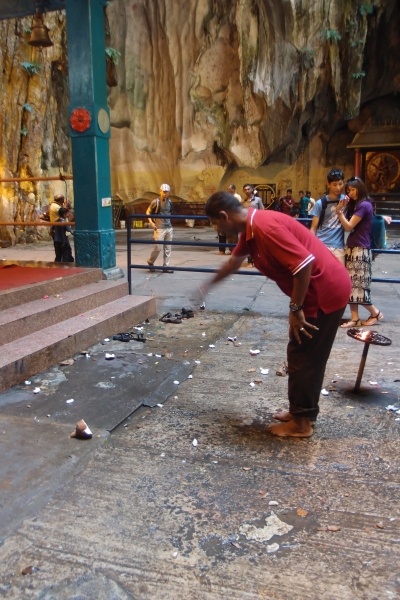
A local devotee throws a coconut onto the ground. It breaks into pieces.
Pottering about the caverns are roosters (I could also hear them crowing if I could not see them). Roosters, along with peacocks, are the mounts of Murugan. Mounts? Each of the Hindu deities would have their varanas, or animals which they use as their vehicle. And Murugan’s happen to be roosters, which explains why there are chickens at the top of 272 steps.
Wonder #3: Royal Selangor Pewter Factory
I was not expecting to enjoy this Wonder as much as I did. After all, how is it that a pewter making factory is even on the list? I was proven wrong though.
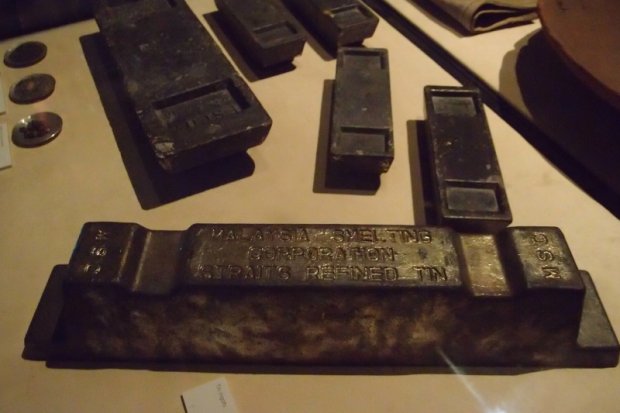
Samples from the Royal Selangor pewter museum
The visit started with an introduction by the in-house guide, who was witty and informative. He explained how pewter was made (alloy of tin, copper and antimony), showed us some very elaborate pieces of pewterware in the museum. He then took us down to the factory itself, where workers did actual demonstrations of the steps involved, from moulding to cutting to filing. We even got to drink 100 plus from pewter cups.
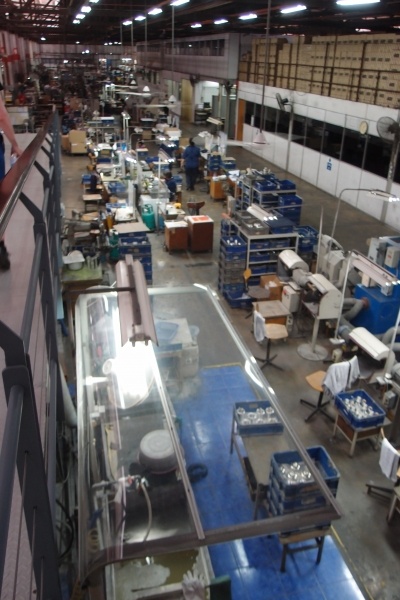
We were brought through an actual pewter manufacturing facility, and watched the various processes involved in pewter making.
The pieces for sale in the gallery on the ground floor were pieces of fine art, each with patterns and designs elaborately knocked into shape. There were bowls, cutlery, frames, and pendants, amongst others. Some of the costliest items were priced in the thousands.
Lunch: Kampung Bahru (Wonder #3.5)
I’m classifying our lunch point as a wonder in itself. Kampung Baru, where we had lunch, is a traditional Malay village located right in the middle of Kuala Lumpur’s bustle. A little enclave amongst tall skyscrapers and busy streets. It came to be when the colonial powers in the early 20th century created it to encourage Malays to migrate into the city, yet retain their traditional way of life. Kampung Baru today is a bastion of simple living, holding out against development.
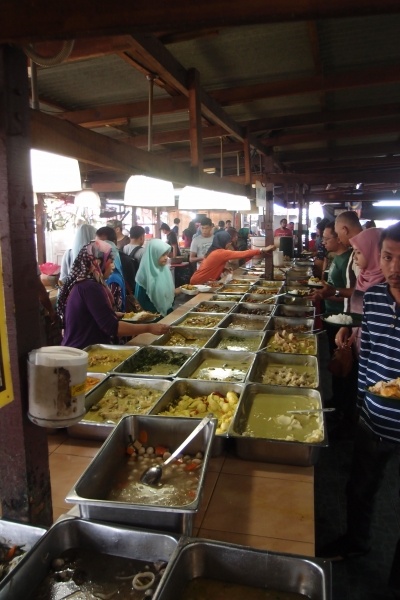
Lunch is a pay-for-what-you-pick affair over a large buffet like spread in Kampung Baru.
Lunch at the open-air hawker stalls in Kampung Bahru was an experience. It was a very communal affair, with rows and rows (and rows) of dishes to choose from. You simply get a plate of rice, scoop up all the dishes you want and pay accordingly later. I picked out a few dishes to sample, delicious. There was even live entertainment, some youths playing the guitar and singing.
Also read: FOOD WAR! Singapore vs Malaysia – Who’s Better?
Wonder #4: The National Mosque of Malaysia
We continued after lunch (burp!) to the next Wonder: The Masjid Negara, or National Mosque. The building, recognisable by its 73m high minaret, was built in 1965 and can seat 15000 worshippers at any one time. The main prayer hall was high-ceilinged, with large windows that let light in.
Also read: Putra Mosque: a Rose-Coloured Dome Full of Beauty
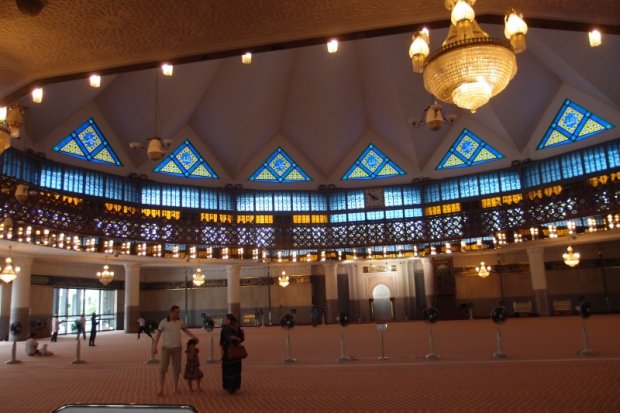
The main prayer hall of the National Mosque.
Of course, we had to be dressed appropriately to enter the mosque. I was fine, but the rest were given robes to wear. The robes, I have to say, made them really look like characters from a Star Wars movie set. We spent another twenty minutes or so looking around and taking photos, and listening to a caretaker-guide explaining about the mosque.
Also read: 5 Important Asian Taboos You Must Know
Wonder #5: The National Monument
The National Monument is a towering sculpture of soldiers, one holding the national flag. The seven bronze figures symbolises leadership, suffering, unity, vigilance, strength, courage and sacrifice. The monument was set up to commemorate the dead who fought in the World War II and the Malayan Emergency. A cenotaph nearby commemorates those who fought in World War I, with their names inscribed on it. Interestingly, the faces of the soldiers do not look Malaysian at all. And this was because the artist who was commissioned to do up the sculpture was the same guy who made the famous Iwo Jima Memorial in the US.
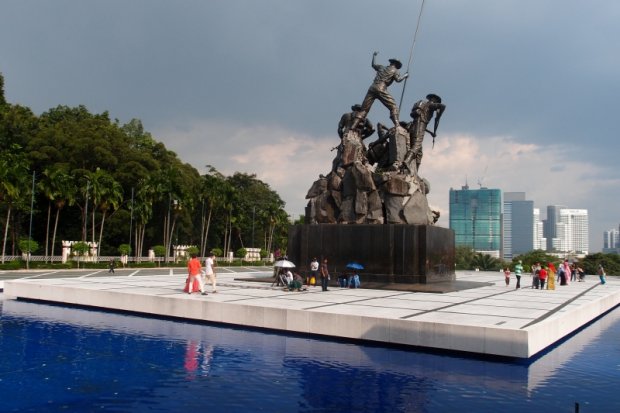
The National Monument, and in the foreground, a film crew filming two dancers over a Bollywood number.
Besides the sculpture, the memorial park also had other visitors, the most fascinating were the group who were apparently filming some sort of Bollywood style dancing. The guy and the girl would dance to the beat of music, before the director would cut in and order a retake after giving instructions. Over and over again, very much the perfectionist. Too perfect, probably, as it started to drizzle and they had to clear up the set. Haha.
And that was the end. Unfortunately for me, I had to catch a flight back home, and had to forego the last two Wonders. It was still a very enjoyable experience. I was not expecting much, and so was pleasantly surprised by all the various sites around KL. My conclusion? KL is not just all shopping and glitzy skyscrapers. There is plenty more!
And here, for the sake of you readers who are interested, are the other two Wonders.
Wonder #6: The Thean Hou Temple and Little Indian Brickfields
The Thean Hou temple is one of the largest Chinese temples in Kuala Lumpur. Little India Brickfields is a place to learn about Hindu culture and temples.
Wonder #7: National Palace
The National Palace is the official residence of the head of state of Malaysia.
Also read: 8-Days Quick Guide to the Best of Malaysia
Add these 7 wonders when you plan a getaway to Kuala Lumpur.
Contributed by The Furious Panda.






